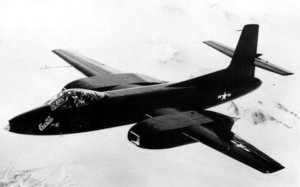XF-87 Blackhawk
|
|
| Curtiss XF-87 Blackhawk | ||
|---|---|---|
 Curtiss XF-87 Blackhawk | ||
| Description | ||
| Role | all-weather interceptor fighter | |
| Crew | two - pilot, radio operator | |
| First flight | March 5, 1948 | |
| Manufacturer | Curtiss-Wright | |
| Dimensions | ||
| Length | 62 ft 0 in | 18.9 m |
| Wingspan | 60 ft 0 in | 18.3 m |
| Height | 20 ft 4 in | 6.2 m |
| Wing area | 600 ft² | 55.7 m² |
| Weights | ||
| Empty | 25,930 lb | 11,760 kg |
| Loaded | lb | kg |
| Maximum takeoff | 49,900 lb | 22,600 kg |
| Capacity | ||
| Powerplant | ||
| Engines | 2 × Westinghouse XJ34-WE-7 turbojets | |
| Thrust | 3,000 lbf (each) | 13 kN |
| Performance | ||
| Maximum speed | 600 mph | 970 km/h |
| Combat range | 1000 miles | 1,600 km |
| Ferry range | miles | km |
| Service ceiling | 41,000 ft | 12,500 m |
| Rate of climb | ft/min | m/min |
| Avionics | ||
| Avionics | ||
| Armament | ||
| Guns | 4 × 20 mm cannon in nose turret (never fitted) | |
The Curtiss-Wright XF-87 Blackhawk (formerly designated as the XP-87 and XA-43) was a prototype all-weather jet interceptor fighter aircraft and the company's last plane. Designed as a replacement for the P-61 Black Widow, the XF-87 lost to the Northrop F-89 Scorpion. The loss of the contract was fatal; the Curtiss-Wright Corporation closed down its aviation division, selling its assets to North American Aviation.
The aircraft started life as a project for an attack aircraft, designated XA-43. When a USAAF requirement for a jet-powered night and all-weather fighter was issued in 1945, the design was reworked for that requirement. The air force at first favored Curtiss' proposal, for political reasons as much as technical.
The XP-87 as it was then designated was a large mid-wing aircraft with four engines paired in underwing pods, with a mid-mounted tailplane and tricycle undercarriage. Two crew members (pilot and radio operator) sat side by side under a single canopy. Armament was to be a nose-mounted powered turret containing four 20mm cannon, but this was never fitted to the prototypes.
The first flight was on March 5, 1948. Although the top speed was slower than expected, the aircraft was otherwise acceptable, and orders for 57 F-87A fighters and 30 RF-87A reconnaissance planes were placed just over a month later. Since the performance problems were due to lack of power, the four Westinghouse XJ34-WE-7 turbojets of the prototypes were to be replaced by two General Electric J47-GE-7 jets in production models. One of the two XF-87 prototypes was to be converted to the new powerplants for test purposes.
It was at this point that the USAF decided that - as much as it wished, politically, to keep Curtiss alive - the Northrop F-89 Scorpion was a much more promising aircraft. The F-87 contract was cancelled on October 10, 1948, and both prototypes were scrapped.
External link
- USAF Museum: XF-87 (http://www.wpafb.af.mil/museum/research/fighter/f87.htm)
| Related content | |
|---|---|
| Related development | |
| Similar aircraft | |
| Designation series | |
| Related lists | List of military aircraft of the United States - List of fighter aircraft |
|
Lists of Aircraft | Aircraft manufacturers | Aircraft engines | Aircraft engine manufacturers Airports | Airlines | Air forces | Aircraft weapons | Missiles | Timeline of aviation |
